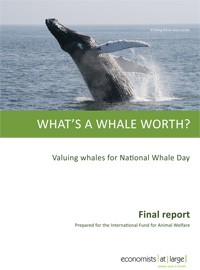On the eve of National Whale Day 2011, this report demonstrates the value that whales have to Australia. This report uses tourism revenue data from earlier IFAW reports and estimates of local whale populations to estimate tourism values per whale, providing a quantifiable answer to the question “What is a whale worth?”.
Humpback (Megaptera novaeangliae) and southern right (Eubalaena australis) whales are important species for whale watching in Australia and are the focus of the case studies in this report. Populations of humpbacks migrate up the east and west coasts, while southern rights migrate mainly to the south coast. Each distinct population of both species has been recovering since being seriously depleted by commercial whaling last century, but still face significant challenges.
Australia has a well-established commercial whale watching industry, with operations in every state. While a wide range of species is sighted, humpback whales are the focus of whale watching on the west and east coasts, while southern right whales are the focus along the southern coast. Over 1.6 million people went whale watching in Australia in 2008, generating AUD $47 million in ticket expenditure and AUD $264 million in total tourism expenditure. This represents an increase in direct expenditure of nearly 600%.
|
Year |
Direct expenditure (AUD millions) |
Total expenditure (AUD millions) |
|
1991 |
$6.8 |
$71.2 |
|
1994 |
$8.9 |
$85.7 |
|
2000 |
$19.9 |
$98.6 |
|
2003 |
$34.2 |
$321 |
|
2008 |
$47.1 |
$264.3 |
Assigning a value to natural resources is complex and involves many assumptions, beginning with the acknowledgement of the limitations of the approach – that we are choosing to exclude a range of tangible and intangible values that whales have both for humans and for the wider ecosystem.
We have calculated total tourism revenue related to whale watching in three locations and averaged this figure across the local whale population. This annual value is then used to calculate the present value of each whale’s average tourism revenue through its lifetime, at an appropriate, normative discount rate.
The three research locations are Hervey Bay, Warrnambool and Broome. The final results for each area are presented in the table below.
|
Area |
Number of tourists (2008) |
Local whale population |
Average present value per whale* |
|
Hervey Bay (QLD) |
64,260 |
3,956 |
AUD $97,000 |
|
Warrnambool (VIC) |
37,190 |
50 |
AUD $1,259,000 |
|
Broome (WA) |
2,000 |
383 |
AUD $32,000 |
* based on whale life expectancy at 2.65% discount rate.
Hervey Bay in Queensland is the oldest humpback whale watching location in Australia, with many operators taking visitors to see the part of the eastern Australian humpback population that enters the bay. With its well-established industry and recovering whale population, we estimate the present value of a humpback whale to the Hervey Bay economy to be $97,000.
Southern right whales visit Warrnambool in Victoria every year, with mother and calf pairs often staying for extended periods in bays close to town. Whale watching is undertaken mainly from a viewing platform on land. With large numbers of tourists coming to see a relatively small population of whales, we estimate the present value of a southern right whale to the Warrnambool economy to be $1,259,000. This value is significantly higher than the values in Hervey Bay and Broome because revenue from whale watching in Warrnambool is high and the population is very small compared to the other two regions.
Broome in the north of Western Australia is a relatively new whale watching location, with around 10 boat-based operators taking visitors to see whales from the western Australian humpback population. This humpback population is thought to be the largest in the world. With a relatively large population of whales and a new whale watching industry, we estimate the present value of a humpback whale to the Broome economy to be $32,000.
The whale watching industries in each town are at different stages of development and offer different whale watching experiences. The difference between the locations is evident in the estimated values per whale for each location, ranging between $32,000 and $1.25 million. Tourism revenues and whale populations are clearly related since without whales, the industry wouldn’t exist. Beyond that obvious statement, the link between tourism revenue and whale populations is more complex. What is certain is that healthy and abundant populations of whales are important to support a large and diverse whale watching industry along Australian coastlines and to enhance the intensity of the tourism experience in a particular location.
Despite their high value to the Australian economy and the growing Australian whale watching industry, whale populations are still under threat. Resumption of whaling, climate change, prey depletion, habitat loss and increased marine activity pose multiple threats to whale populations in the future. A robust, coordinated policy response to these threats, in Australian State and Commonwealth waters as well as in the Antarctic, will be essential to ensure their continued recovery and their continued contribution to the economies of Australian coastal communities

